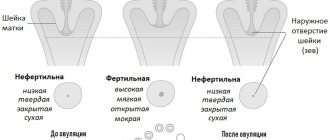Every expectant mother dreams that her pregnancy will proceed easily and calmly and end with the birth of a long-awaited baby. But, unfortunately, this is not always the case. Some disorders in the female body can cause a threat of termination of pregnancy in the first trimester, while others, which is even more sad, in the second or even third. And among such problems, which often become the cause of late spontaneous miscarriages or premature births, is isthmic-cervical insufficiency (ICI).
Uterine os during pregnancy
Before a toddler appears in the expectant mother's womb, she may not even know what the os of the uterus is and what it should be like. Let's look at the anatomy. A woman’s uterus is a hollow, pear-shaped organ within which the baby develops and grows. The uterus is separated from the vagina by the uterine cervix (cervix uteri) - a canal 3-4 cm long and 7-8 mm wide, one part of which opens into the uterine cavity, the other is directed into the vagina. The term "os" combines these two openings of the cervical canal - the upper and lower exit of the cervix. If a woman is pregnant for the first time, the uterine os has a transverse oval shape. Subsequently, the shape of the hole changes and takes on the appearance of a transverse slit, but the pharynx is still closed during pregnancy. With the appearance of a toddler in a woman’s uterus, a dense mucus plug forms in the cervical canal, which serves as an additional protective barrier against infections for the baby. With the onset of labor, the pharynx opens and the plug comes off.
What is an internal os during pregnancy?
The upper opening of the uterine cervix, directed towards the uterus itself, is called the internal os. That. the internal os is the end of the supravaginal part of the cervix, the edge of the cervical canal. It cannot be seen with the eyes or touched in any way. The physiological norm is the closed state of this hole, always. The only exception is the period of menstruation and childbirth. If artificial access to the uterine cavity is necessary, the internal os is opened mechanically. The main function of the internal pharynx is protective. With the onset of pregnancy, a tightly closed opening prevents various types of infections from entering the uterine cavity and does not allow the baby to come out before the due date. When the internal os is closed during pregnancy, this is the norm. The condition of the internal pharynx is monitored by assessing its location, density and diameter. If pregnancy proceeds without complications and pathologies, control is carried out at the 20th, 28th, 32nd and 36th weeks.
What is the external os during pregnancy?
The external os characterizes the area where the cervix enters the vagina, the beginning of its vaginal part, which leads from the vagina to the cervical canal. It is this hole that is accessible to observation during a gynecological examination. The shape of this hole also differs between women who have given birth and those who have not. If it is the first pregnancy, the hole is round; if not, it is slit-like. An increase in the diameter (opening) of the external pharynx also requires additional control and, if necessary, measures. The situation is fraught with the onset of labor earlier than expected.
Structure of the cervix
Anatomy of the female reproductive system
The cervix is structurally a ring of muscle tissue located in the lower part of the uterus. Its main function is to connect this organ with the vaginal canal. Menstrual fluid is also removed through the cervical canal. Through the cervix, sperm reach the egg for fertilization.
Normally, the neck length parameter should be in the range from 34 to 35 millimeters. The organ is conventionally divided into two structural units:
- The internal section located closer to the uterus (uterus).
- The external section, located closer to the vagina.
The shape of the cervix may change. Before delivery begins, it has a flat shape, resembling a cylinder in appearance. After childbirth, the organ acquires a trapezoidal shape. Also, the parameters of the cervix may change after surgical interventions affecting this anatomical area.
During pregnancy, the cervical canal should be closed. During the studies, not only the total size is determined, but also the length of the closed part of the cervix - this is required when identifying the risk of premature birth.
Functions of the cervix important when carrying a child
- The cervix during pregnancy has defining functions, which include:
- Protective. It consists in preventing the penetration of pathogens - causative agents of infectious diseases. The mechanism for implementing this function is the production of special mucus, from which a plug is formed.
- Holding the baby inside the uterus. To implement this function, the length of the cervical canal is extremely important. A deviation of the parameter from the norm to a lesser extent impairs the ability of the cervix to hold the child.
So what should be the length of the cervix during pregnancy? Before answering this question, you should study ways to study the parameter.
Cervical pharynx during pregnancy: reasons for opening and danger of pathology
To correct the situation and eliminate the disease, timely diagnosis of the pathology is important. The greatest danger of cervical dilatation lies in its almost asymptomatic occurrence.
Causes of throat opening during pregnancy
What factors can provoke opening of the pharynx?
- Hormonal imbalance.
An increased content of male hormones in a pregnant woman’s body provokes early ripening of the cervix. Women who have similar problems should be especially careful and control the diameter of the cervical pharynx.
- Multiple pregnancy.
Having several babies in the womb is a serious test for the whole body. The cervix also experiences increased pressure, which can lead to its early opening - an increase in the diameter of the pharynx.
- Injuries and pathologies of the cervical canal itself.
This factor is due to possible infectious diseases of the genital area (including a history), as well as mechanical manipulations on the cervix.
- ICI—isthmic-cervical insufficiency.
The weakening of the muscles of the cervix leads not only to its premature shortening, but also to the opening of the pharynx.
The danger of cervical dilatation lies in its practically asymptomatic course. In some cases, a pregnant woman may complain of soreness or a feeling of tension in the lower abdomen. But even such manifestations do not always happen.
Open throat during pregnancy - should you panic?
As was previously said, the pharynx can be external and internal. If the doctor has diagnosed a dilated throat, should you be nervous? Of course, the wording “opening the throat” does not put you in a good mood, but you shouldn’t fall into despair either. The greatest threat to the successful bearing of a baby is the opening of the internal pharynx - that part of the cervical canal that opens the entrance to the uterus and which is not visible when examined on a chair. Fixing this moment during an ultrasound is an alarming signal and should not be ignored under any circumstances. When it comes to opening the external pharynx - the vestibule of the vagina from the side of the cervix - the situation is not always critical. If during a gynecological examination the doctor has determined that the external os is dilated:
- First, ultrasound control is necessary to establish the condition of the internal pharynx.
- The second is evaluating the results. If the internal hole is closed, there is no reason to panic. Calm and observation of the situation is required. If the internal hole is also slightly open, radical measures are required. The latter include suturing the neck or installing a pessary.
What is the cervical canal
The cervical canal is the canal of the cervix, connecting the vagina and the cavity of this organ. It has two small holes - the internal and external pharynx, the normal diameter of which is 2-3 millimeters. The external pharynx is visible during a standard examination, has a dotted shape if the woman has not given birth, and after childbirth or abortion it becomes slit-like. The layer of mucous membrane covering the cervix is called the endocervix.
Atresia of the cervical canal
A disorder that results in fusion or obstruction of the cervix is called cervical atresia. The disease can be a congenital pathology or acquired as a result of illness or injury. Congenital disorders are cases of abnormal formation and development of internal organs. Acquired atresia in most cases is caused by abortion, cervical cancer, inflammation in the inner and outer layers of the canal tissue.
The cervical canal is closed, what does this mean?
Whether the sperm will pass through to the egg largely depends on the condition of the cervix. When the cervix is completely or partially closed, doctors diagnose stenosis. It can be distinguished by the following symptoms: absence or painful menstruation, infertility, pain during sexual intercourse. A narrow cervical canal and conception are poorly compatible; first you need to eliminate the cause, then carry out bougienage. If you still manage to get pregnant with this disease, there is a high probability of incoordination of labor and subsequent cesarean section.
The cervical canal is dilated, what does this mean?
At any stage of pregnancy, the doctor can report the news that the cervical canal is dilated - what does this mean? This means that the cervix cannot perform its functions of holding the fetus. Enlargement of the cervical canal can be caused by an increased amount of male hormones that soften the cervix, multiple pregnancies, developmental abnormalities and injuries. The following steps can be taken to prevent a possible miscarriage:
- medications are prescribed that strengthen the cervix;
- installation of a special ring, which will be removed only at 37 weeks;
- stitches were placed around the cervix.
Normal pharynx during pregnancy
The parameters of the cervix - not only its length and condition, but also the size of the pharynx - an important diagnostic indicator that helps to identify cervical weaknesses in the early stages and promptly take the necessary measures for the safe bearing of the child. Normally, the throat of the cervix (both external and internal) should be closed, the diameter of the hole is most often within 2-3 mm, but should not exceed 6 mm. If pregnancy proceeds without the threat of premature termination, this picture persists from the 10th to the 36th week. Particular attention is required in situations where the expansion of the pharynx occurs at a period of less than 20 weeks.
The pharynx is dilated during pregnancy
Cervical dilatation can be diagnosed both during a gynecological examination in a chair and during an ultrasound.
It is worth clarifying that:
- On the chair, the doctor is able to establish the fact that only the external pharynx is dilated (a finger passes into the canal), the internal pharynx is not visible to him.
- A woman can find out about the condition of the internal pharynx based on the results of an ultrasound examination (ultrasound).
Prevention
To avoid unnecessary worries, it is important for the expectant mother to monitor her well-being and not ignore timely medical examinations at the antenatal clinic. Preparation for pregnancy is of great importance, during which any gynecological and endocrine pathologies are excluded, and, if necessary, they are treated.
A woman must also maintain intimate hygiene - wash herself daily and change her underwear frequently. It is prohibited to use the douching method during pregnancy, since external influence on the cervical canal can cause infection or injury to the mucous membrane. This also applies to too active sexual relationships - violent sexual intercourse can lead to the same consequences. Read more about dangerous and safe sex positions during pregnancy →
The condition of the cervical canal during pregnancy is an important indicator on which the birth of a baby at term depends. To prevent possible problems, it is recommended to visit a doctor on time, take tests and undergo an ultrasound. Monitoring your health and the course of pregnancy can fight back any complication.
Author: Olga Rogozhkina, obstetrician-gynecologist, especially for Mama66.ru
Source: mama66.ru
The internal os is open during pregnancy: pathology control
Diagnosing the opening of the internal pharynx requires taking action. Which ones exactly depends on both the degree of expansion of the canal and the duration of pregnancy.
- Drug therapy. In a hospital setting and on bed rest, the woman undergoes treatment using hormonal agents, vitamins and antispasmodics, and magnesia.
- Installation of a special ring on the neck - a pessary. A structure made of plastic or silicone is placed on the neck, thereby strengthening its walls. As a result, the process of opening the pharynx can be restrained. The ring is most often applied after the 20th week and removed at the 37th week. The procedure is performed without anesthesia. The doctor lubricates the pessary with silicone, inserts it through the vagina and places it on the cervix.
- Surgical intervention - suturing the neck. In this case, either a circular suture can be applied, leaving a drainage gap, or the external pharynx - the anterior and posterior lips of the cervix - can be completely sutured. The second method is less popular, because the created closed space is a favorable environment for the development of infection. The operation is performed before the 28th week of pregnancy.
Unfortunately, taking even radical measures is not always able to save a pregnancy.
Causes
The uterine sphincter keeps the uterus in good shape, and during the period of bearing a child, it controls that dilatation does not occur before the due time. With ICN, the process is disrupted.
The main reason is cervical injury.
- with a history of abortions or fetal-destroying operations;
- having internal breaks;
- those who have undergone surgical delivery using obstetric forceps or in a breech presentation;
- after surgery on the cervix.
These procedures disrupt muscle fibers, reducing overall tone.
ICI also occurs when the structure of a woman’s reproductive organs is abnormal. Congenital isthmic-cervical insufficiency is rare and can be diagnosed even in a non-pregnant patient; in this case, cervical dilatation is observed at ovulation of more than 0.8 cm.
Other reasons:
- with an increased content of male hormones in the body (hyperandrogenism);
- polyhydramnios – there is additional pressure on the cervical canal and it cannot cope;
- large fruit;
- in patients over the age of 30, the risk of ICI increases;
- conception using IVF;
- observed in patients who engage in heavy physical work during pregnancy.
Prevention of throat opening during pregnancy
If a woman is at risk of premature opening of the internal os, the following recommendations should be followed:
- Exclusion of intimate relationships for the entire period of bearing the baby.
- Avoid physical activity, especially heavy lifting.
- Limit consumption of coffee and chocolate, follow the diet recommended by your doctor.
- Minimize exposure to stuffy and hot rooms.
- Limit sun exposure.
- Avoid visiting steam rooms and taking hot baths.
Structure of the cervix
Anatomy of the female reproductive system
The cervix is structurally a ring of muscle tissue located in the lower part of the uterus. Its main function is to connect this organ with the vaginal canal. Menstrual fluid is also removed through the cervical canal. Through the cervix, sperm reach the egg for fertilization.
Normally, the neck length parameter should be in the range from 34 to 35 millimeters. The organ is conventionally divided into two structural units:
- The internal section located closer to the uterus (uterus).
- The external section, located closer to the vagina.
The shape of the cervix may change. Before delivery begins, it has a flat shape, resembling a cylinder in appearance. After childbirth, the organ acquires a trapezoidal shape. Also, the parameters of the cervix may change after surgical interventions affecting this anatomical area.
During pregnancy, the cervical canal should be closed. During the studies, not only the total size is determined, but also the length of the closed part of the cervix - this is required when identifying the risk of premature birth.
Functions of the cervix important when carrying a child
- The cervix during pregnancy has defining functions, which include:
- Protective. It consists in preventing the penetration of pathogens - causative agents of infectious diseases. The mechanism for implementing this function is the production of special mucus, from which a plug is formed.
- Holding the baby inside the uterus. To implement this function, the length of the cervical canal is extremely important. A deviation of the parameter from the norm to a lesser extent impairs the ability of the cervix to hold the child.
So what should be the length of the cervix during pregnancy? Before answering this question, you should study ways to study the parameter.
Bacterial culture from the throat of the cervix during pregnancy
The study of bacteriological culture from the cervical canal is an important criterion for assessing the health of the genital area of a pregnant woman and choosing treatment tactics. The reason for prescribing this study is the presence of an inflammatory process (increased white blood cells in a regular smear). If the inflammatory process affects the cervix, the disease is called cervicitis (or endocervicitis). If left untreated, the pathology often causes miscarriages and premature births.
- The biomaterial is collected with a sterile stick from the cervical canal - the secretion of the glands and desquamated cells (carriers of microflora).
- Before the procedure, you must refrain from any hygienic manipulations; you should not use intimate creams and vaginal suppositories.
- It is also worth excluding sexual relations (one day before the test) and taking antibacterial drugs (at least 1 week before the test).
As a result of bacterial culture analysis, it is possible not only to determine the type of pathogenic pathogen, but also to determine its sensitivity to antibacterial drugs that will be necessary for treatment.
Timely diagnosis of the condition of the cervix and its pharynx allows you to take the necessary measures in time and maintain the pregnancy.
What causes parameter deviations from acceptable values
If you analyze the information presented above, you can understand that the length of the cervix by week of pregnancy may deviate from acceptable values in the following cases:
- Hormonal imbalance. Hormones control the normal course of pregnancy and the preparation of the woman’s reproductive system for childbirth, so any fluctuations in the endocrine balance can provoke disturbances in the anatomy and functionality of the cervix.
- Previous injury to the cervix - during abortion, surgical interventions, during previous births. Injuries to the cervical canal can cause both its shortening and lengthening.
- Infectious diseases of the reproductive system. Frequent infectious and inflammatory pathologies cause significant harm to a woman’s reproductive health.
- Features of anatomy in a specific clinical case.
- Stressful situations. It is not for nothing that they say that peace is extremely important for a pregnant woman. A stable state of the nervous system allows maintaining an acceptable neurohumoral balance. Frequent stress provokes various pathologies during pregnancy.
Constant monitoring of the parameter value is necessary not only in the above cases. Pregnancy management must take into account the size of the cervical canal
Source: shejka-matki.ru
What causes parameter deviations from acceptable values
If you analyze the information presented above, you can understand that the length of the cervix by week of pregnancy may deviate from acceptable values in the following cases:
- Hormonal imbalance. Hormones control the normal course of pregnancy and the preparation of the woman’s reproductive system for childbirth, so any fluctuations in the endocrine balance can provoke disturbances in the anatomy and functionality of the cervix.
- Previous injury to the cervix - during abortion, surgical interventions, during previous births. Injuries to the cervical canal can cause both its shortening and lengthening.
- Infectious diseases of the reproductive system. Frequent infectious and inflammatory pathologies cause significant harm to a woman’s reproductive health.
- Features of anatomy in a specific clinical case.
- Stressful situations. It is not for nothing that they say that peace is extremely important for a pregnant woman. A stable state of the nervous system allows maintaining an acceptable neurohumoral balance. Frequent stress provokes various pathologies during pregnancy.
Constant monitoring of the parameter value is necessary not only in the above cases. Pregnancy management must take into account the size of the cervical canal
Source: shejka-matki.ru
A couple of days ago, the gynecologist told me that I have a short cervix. Since then I have been terribly afraid. I found an article by an honored obstetrician-gynecologist, she says that there are cases when a pessary is placed for no reason due to illiteracy. Below are a few of her quotes.
Memo:
— Women whose cervical length is less than 1.5-2 cm can be observed in the hospital. A length of up to 2.5 cm is considered normal.
Question:
20 weeks pregnant and a bad cervix. Opened to 38 mm. Tests for torch infection are negative. The smear for ureaplasma and mycoplasma is good. The level of leukocytes is slightly elevated (this is why I take an antibiotic). The ring is not placed, again, due to the increased level of leukocytes. There are no longer any symptoms of the inflammatory process in the body. What could be the reasons (from the above)? So what should we do?
Answer:
It is necessary to clarify whether you have confused anything, just like your doctors too. Perhaps 38mm is the length, not the diameter. You need to clarify the following:
1. What is the length of the cervix according to ultrasound 2. What is the condition of the INTERNAL os.
Rings, like pessaries, do not preserve pregnancy, so they are not used in obstetrics. Also, a suture is placed on the cervix depending on the length of the cervix. With such an opening, they usually do not place it. Leukocytes in discharge during pregnancy are normal. After clarifying the questions, if you really have a short and open cervix, you should be in the hospital. Bed rest does not preserve such pregnancies, so lying down all the time is useless. Various medications are not indicated for you, since tocolytic therapy at this stage and with an open cervix is also contraindicated. All that remains is to wait.
Question:
There is a threat of pregnancy, the term is 24 weeks. There is no ICI, but I was recently treated for infections. Since 12 weeks, doctors say that I have a short cervix (at 12 weeks it was 28 mm), at 20 weeks they performed an intravaginal examination - 23 mm and the opening of the internal os is 3.8 mm. Since 20 weeks I have been drinking Utrozhestan 200 in the morning and 200 in the evening. In my city of Ilyichevsk, doctors insist on putting on a pessary, but in Odessa they are against it. Who to listen to? What should you do in such a situation? How to increase the chances of maintaining a pregnancy?
Answer:
If this is your first pregnancy, it is very often difficult to detect the moment of shortening of the cervix before 20 weeks, because usually the second ultrasound is performed at 19-20 weeks. Risk factors for the occurrence of isthmic-cervical insufficiency are taken into account. 28 mm is considered normal, so additional cervical monitoring was not prescribed. 23mm and a dilated os means there is a 50% chance of giving birth within 2 weeks. Tocolytic therapy is not prescribed, especially since there is no labor. Utrozhestan in the form of tablets is NOT effective in this case (and this has been proven). Some doctors recommend vaginal progesterone suppositories from 24 to 32 weeks of pregnancy, but most still do not prescribe them because the effectiveness of such therapy is very low. A pessary is not recommended, as it is a foreign body and has no effectiveness; on the contrary, it can speed up labor. Bed rest also does not preserve such pregnancies. This means that the only possible option may be the vaginal use of progesterone, and not in the form of tablets by mouth.
Question:
At a routine ultrasound at 32 weeks, a short cervix of 1.5 cm was determined. Before this, she led a normal lifestyle: walking, water aerobics, light exercises in the morning, pleasant household chores. I felt and feel fine. After the ultrasound, we were admitted to the hospital to be observed for a week, a CTG was performed, the abdomen was examined, no medications were prescribed. After a week of hospitalization, from weeks 32 to 33, she was discharged with a recommendation for the most relaxed regimen possible: lie down, don’t be nervous, don’t lift heavy objects, saying that there are no indications for hospitalization yet. You just need to take care of yourself. At discharge, the length of the cervix was 1.36 cm. The LC also gave similar recommendations. I'm now at the start of my 36th week, and since 33 weeks I haven't been examined in the gynecologist's office or had an ultrasound. Should I independently sign up for an intermediate ultrasound or visit an additional gynecologist and insist on an examination in order to understand the situation? Or is unnecessary intervention not very desirable? What actions should I take and behave in this situation? Scheduled inspection at the residential complex at the end of next week. Daily routine: I lie down a lot, walk a little, do light housework.
Answer:
This is an extremely correct, progressive approach to managing a woman with a short cervix, especially at this stage. Bed rest does not preserve such pregnancies, so it is not recommended, although limiting physical activity and stress is necessary. On the contrary, bed rest significantly increases the risk of blood clots and thromboembolism, and this is worse than premature birth. There is not much time left before birth, so an ultrasound at 36 weeks to determine the length of the cervix is no longer so important. A short cervix means a woman has a 50% risk of going into labor within the next two weeks. You have passed this milestone, i.e. you fell into the other 50%, and did not give birth prematurely. Therefore, carry your pregnancy to term calmly. Your baby has almost a 98% chance of being born alive and healthy. This percentage will practically not rise higher. So, everything is fine.
Question:
Pregnancy 23-24 weeks. Three weeks ago a ring (pessary) was placed because... the cervix was 29 mm. Now I use Utrozhestan suppositories 200 mg 2 times a day until 30 weeks. Do I need to check the ring and do I look at the neck? And was this ring installed correctly at all?
Answer:
Your doctors are engaged in sabotage. Real sabotage. You have a NORMAL cervical length, so a pessary is NOT indicated for you, just as Utrozhestan is NOT indicated.
Source: www.baby.ru









